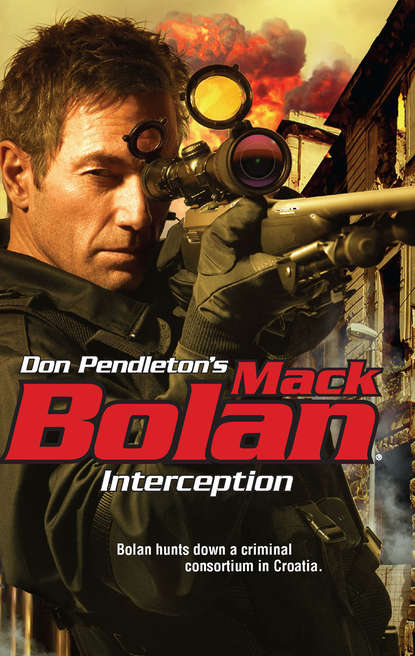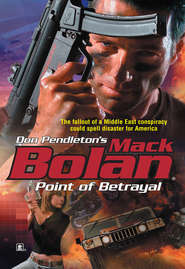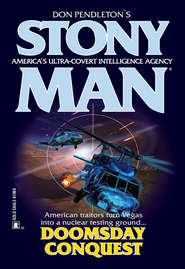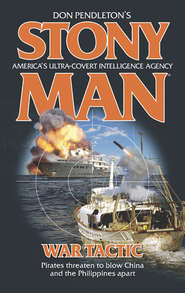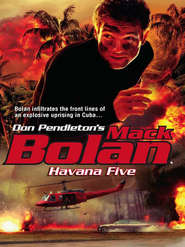По всем вопросам обращайтесь на: info@litportal.ru
(©) 2003-2024.
✖
Interception
Автор
Год написания книги
2019
Настройки чтения
Размер шрифта
Высота строк
Поля
Given the choice, Bolan would have preferred walking in, cutting through the DMZ to the south by means of routes already secured and verified by Special Forces teams assigned full-time to covert LRRP/SU ops in the no-man’s land between the north and south of the Asian peninsula.
But as happened so often when Stony Man Farm and the Executioner were called into play, the operation depended on complete invisibility while at the same time remained hamstrung by timing. The train Bolan intended to intercept was going to be on target on time, and only for that time. The Oval Office wanted a surgical strike with no collateral damage.
The land was arrayed below the plummeting commando in an uneven checkerboard of blacks and grays. He flared his canopy hard at the last moment, attempting to curtail his momentum as the ground rushed up. He heard then felt his rucksack crash into the copse of trees, then two heartbeats later his feet, tightly clamped together, broke through the mesh of interwoven branches at the top of the canopy. He kept his legs pressed together as gravity yanked him down through branches and tree trunks. He took several bone-jarring impacts before his parachute caught and his neck whip-lashed hard into the special support collars leaving him sore but unharmed.
Taking stock of his surroundings, he looked down and saw he was about forty feet from the ground, caught halfway up a good-size evergreen. His chute seemed securely trapped above him, but he was too far out from the main trunk for the branches to have enough girth to support him.
Hitting his quick-release clip, Bolan let his rucksack fall, then pulled himself along the branches of the pine tree until he was on a more stable support. He disengaged the jump harness and secured his nylon ribbon of a rappel cord from a pocket in the lower leg of his padded suit.
He slipped the strong, flat cord through a D-ring carabiner positioned at his waist and kicked away from the tree, dropping to the ground in a smooth arc. On the forest floor he quickly removed his jumpsuit, helmet and supplemental oxygen along with the rest of his rappel harness. He made no effort to retrieve his chute and paid only cursory attention to camouflaging the gear he was leaving behind. If there was anyone close enough to stumble onto it in the dark, then the mission was probably blown in any case.
From his pack Bolan secured first his primary weapon, a Chinese model AKM with folding paratrooper stock, and a night-vision-goggle headset. Like a modern-day version of the childhood boogeyman, he hunted at night, could see in the dark and was armed with fearsome claws. Straining against the weight, Bolan slipped into the shoulder straps of his rucksack then took first a GPS reading before double-checking his position with a compass to verify his start point. Satisfied, he set off down the steep, narrow valley toward the dull gleam of the wide river below.
In many ways his cross-country navigation was almost more dangerous than the HAHO jump, or even than the potential difficulties he faced in his coming swim. Every model of night-vision device available offered depth perception difficulties. The scree-covered terrain was rocky and steep, making his footing uncertain, and he was cutting down not an actual path but rather a rain wash gully. With two hundred pounds on his back each step downhill sent a biting jar through his knees and lower back, threatening to turn his ankles constantly as his heels came down on loose gravel and powdered dirt. The topography was so steep and uncertain Bolan spent half the two-kilometer descent sliding on his backside as opposed to on his feet.
By the time Bolan reached the floor of the wash he was drenched in sweat and breathing hard. He squatted among the cover of some weeds and cheat grass behind a row of dense shrubs well back from the two-lane blacktop that ran parallel to the river, resting long enough for his heart rate to recover and his breathing to even out. He washed down a couple of the “Go” pills the military gave their pilots on long flights with a full canteen of water. He then opened his rucksack and broke out the dive gear. By his watch he noted he was seven and a half minutes ahead of his pre-op planned time schedule.
With such a strenuous overland hike and steep descent he had been unable to don his wet suit until just prior to submersion or risk heat fatigue and dangerous dehydration. He quickly stripped and donned the neoprene wet suit. Once he was dressed, he pulled on North Korean army fatigues over the insulated swim gear and retied his combat boots.
He was stripped down to the essentials for his swim, and other than his primary weapon everything he needed was tightly fitted inside an oversize butt pack or secured across his body in the numerous pockets of his fatigues or pouches on his H-harness web gear.
Working quickly he fit the poncho-style vest of the rebreather system over his head and shrugged it across his shoulders before pulling the neoprene hood of his wetsuit into place. He fit the mouthpiece and tested the oxygen circuit. Designed for short, shallow dives, the rebreather offered scuba capabilities while eliminating the telltale trail of bubbles of other commercial diving rigs.
Holding his facemask and swim fins in one hand, Bolan cradled his primary weapon in the crook of his arms and crawled out from his place of concealment and into the mouth of the metal culvert running under the North Korean highway.
Coming out the other side, he slid into the cold, sluggish water of the Yellow River with all the deadly, fluid agility of motion as a hunting crocodile. Once in the water he spit into his mask and rinsed the faceplate before putting it on and then tucked his swim fins into place around his boots.
Submerging into the frigid and inky black he began kicking steadily into the middle of the deep river where the current was strongest. Staying about two yards below the surface, he used the luminous dials of his dive watch to judge the approximate distance of travel.
Bolan surfaced after fifteen minutes and stopped kicking, letting the current carry him in among the heavy beams of the crossed pillars supporting a railroad bridge across the river. Working quickly, he stripped his dive gear and let it float down into the cold gray appetite of the water. Reaching up, he grabbed hold of a wide crossbeam and began to climb.
He pulled himself up, hand over hand, twisting around the cross beams and climbing higher and higher. Above him the horizontal beams housing the tracks grew closer and closer and the wind picked up the nearer he drew to the lip of the canyon. He climbed with his Kalashnikov hung muzzle down across his back, and by the time he reached the top the water had stopped dripping behind him. He double-checked his watch and crawled into position, fitting himself tight into the trestle joist.
Intelligence stated that the protocol for all military rail transports leaving the Yellow River Restricted Military Zone stopped on the other side of the bridge to allow for routine security inspections of transport documents. There were schedules to be kept, protocols to be followed, routines to be adhered to. He would have the three-minute window it took for the brakeman to change the tracks to get out from under the bridge and onboard the train without being seen by the armed sentries of the Army of the Democratic People’s Republic of Korea, the DPRK.
The time frame itself was ludicrous enough, as any delay along the way could have thrown the whole operation into jeopardy, but such a tight schedule hadn’t dissuaded Bolan, and Stony Man hadn’t apologized during his initial briefing.
The Executioner focused wholly on the task ahead of him and with the patience of a trapdoor spider as he lay in wait as the North Korean freight train approached then skidded to a stop in a shower of sparks and the harsh squeal of steel-on-steel. Spotlights glared down the length of the track as the military checkpoint on the far side of the bridge followed their established practice. This night the institutionalized paranoia of the DPRK would prove well founded.
Bolan scrambled up through the girders and pulled himself onto the train track. He looked down the serpentine length of the transport train toward the lead engine and saw two men in heavy military overcoats climbing into the engineer’s compartment. The searchlight mounted at the top of the checkpoint shack began to rotate and play along the length of the train.
Bolan began to move fast.
He scrambled up next to the coupling housing between two railroad boxcars and out of the path of the advancing searchlight. The powerful beam of illumination ran down the train, and Bolan shrank back into the protective enclosure of the railcar’s shadow. Once it was past, he scrambled upward, climbing smoothly until he reached the apex of the boxcar.
At the summit he slid over the end of the train and quickly scanned in both directions. Five cars down there was a gap between the roofs of the olive-green boxcars, indicating a flatbed railcar. Beneath him the train began to sway as the brakes were kicked off and the engineer let go with a whistle blast to signal the imminent movement of the long train.
The industrial locomotive lurched to a start and began to gather speed, slowly at first but then with greater and greater momentum as the train began to push forward. Bolan hugged the roof as the train moved past the checkpoint and plunged into the sharply mountainous countryside beyond the river. He clung precariously for several minutes as the train finished gathering speed and began placing more and more distance behind it from the access station out of the restricted area.
Finally ready, Bolan lifted up off the roof of the boxcar and began to navigate his way down the line of cars.
THE MISSILE COMPONENTS were housed in wooden crates, but there was no disguising them if a person knew what to look for. The main crates were thirty-two feet long, holding the medium-range intercontinental rockets while additional storage boxes housed the powerful engines and the advanced computer guidance systems inside the conical tips. Stony Man intelligence had them en route to Pyongyang and from there to Iran by freighter.
The Executioner had been deployed to send a message about the traffic of such advanced and powerful weapon systems, and he carried enough Semtex explosives in his kit to guarantee there would be no misunderstanding.
From his position on the boxcar overlooking the flatbed where the pyramid stack of rockets had been secured, Bolan was able to count four guards. The train was traveling at full speed now and the mountain winds were bitter and harsh, driving the sentries into sheltered alcoves. Bolan felt confident he could place his demolition charges unobserved.
He moved quickly, sliding down the iron ladder built into the boxcar. He landed on the access platform just as a fifth soldier, with NCO markings on his uniform, came around the edge of the car on the signalman’s catwalk.
The man was shorter than Bolan by half a foot, stockily built with high, flat cheekbones and dark brown eyes that widened almost comically in surprise at the sudden apparition of a dark-clothed Occidental. The man clawed for a 9 mm Tokarev TT30 pistol as Bolan, hands empty, leaped forward.
The man managed a short bark of surprise before Bolan struck. Lunging forward, the Executioner lifted his left knee to his chest and kicked explosively, driving the heel of his combat boot in the man’s chest and driving him backward over the railing of the catwalk.
The North Korean soldier flipped and struck the basalt-and-gravel dike running next to the tracks in a spinning tumble before bouncing away. Then the racing train was gone and sparks flew as a burst of AKM fire slammed into the railcar next to Bolan’s head.
Spinning, the big American dropped to one knee even as he cleared his silenced pistol from its shoulder holster. From the walkway next to the rockets on the flatbed a North Korean soldier leveled a Chinese AKM at him, aiming for a second burst.
Bolan’s pistol chugged softly and spent brass tumbled out of its breech and off over the edge of the train, as lost in the night as the noncommissioned officer had been. The Korean sentry jerked under the impact of the 3-round burst, his head snapping and blood splashing off to the side. As he tumbled to the floor of the railcar, his partner suddenly appeared directly behind him.
For a heartbeat the two men looked at each other, then Bolan’s rounds found the other man’s chest and he pitched forward, victim of a lead coronary. The man struck the floor of the flatbed, then rolled and was sucked away in a flash.
Bolan leaped forward, grasped the cold metal railing in one hand and vaulted the barrier onto the railcar. The wind cutting across the exposed carriage was hard and cold. He had to move quickly. The burst of weapons fire had to have alerted the other pair of armed guards, but Bolan could only hope that the noise of the train had deafened the reports for any reinforcements positioned inside the railcars.
The Executioner landed hard on his rubber-soled boots, which absorbed some of the shock of his impact. He went down to one knee, then came back up. His right hand tucked his pistol away as his left reached around and swung the silenced Kalashnikov from behind his back on its sling. He took up the assault rifle just as a third North Korean soldier rounded the corner at the far end of the platform, his weapon up and hunting for a target.
Bolan squeezed the Kalashnikov’s trigger and felt the recoil of the long rifle thump into his shoulder. The heavy-caliber rounds burned across the space between the two combatants and ripped the other man apart, then Bolan caught a flash of motion out of the corner of his eye and instinctively pivoted to face the new threat.
CHAPTER TWO
The final guard had circled and climbed over the secured crates housing the disconnected rockets. The muzzle of the man’s weapon blazed a star pattern, but green tracer fire buzzed harmlessly past Bolan as he drew down and punched the man from his perch with a short burst.
Bolan did not hesitate. He sprinted forward, hurtled across the body of the second man he’d killed, and charged down the length of the flatbed. As he ran, he let the silenced AKM drop to his side and pulled his ready-prepped satchel charges from their web belt carriers and rushed to put them into position.
He moved back and forth in a huddled crouch around the ends of the rockets, working with feverish efficiency. The Semtex was such a powerful compound and he had packed so much into his satchels that the procedure wasn’t difficult. Proximity with the engines was enough, and he slapped down the charges and primed their radio receivers for his signal.
He wasn’t interrupted though he knew that with so many of the sentries missing it was only a matter of moments before he was discovered; the law of averages demanded it. He worked coolly, planting the satchel charges as efficiently as he could, then standing and sprinting for the next boxcar. Only one more flatbed to go and he would have ensured the destruction of the rocket housing, guidance systems and engines.
He turned and scrambled to the edge of the flatbed. The train swayed and rolled beneath his feet as he circumnavigated the heavy chain tie-downs and sharp-edged corners of the crates housing the rocket components. Looking back the way he had come, Bolan turned and jumped lightly across the distance between the two railcars, letting his primary weapon dangle off its sling against his torso. He caught hold of the hard steel rungs of the ladder set into the freight car and quickly climbed upward.
As soon as his head cleared the edge of the carriage, wind tore into him. He scuttled over the side, got to his feet, caught his balance and began to move forward. He ran steadily, scanning ahead and hunting for the second flatbed containing the unmarked crates and their deadly payloads. The second hand on his watch continued cutting off segments of time with irrevocable consistency.
Finally he saw the break in the row of boxcars that indicated the second flatbed. On one side of the train the mountainside, thick with evergreens and heavy bushes, rose like a retaining wall while on the other side the drop into the valley was sheer and unforgiving. Bolan’s luck had held mainly due to the relaxed posture of an army long used to a subjugated population and one too technologically and financially challenged to provide its ground units with radio communications.
Bolan stopped running and dropped to one knee, the AKM up and ready. He cursed under his breath. A curve in the track allowed him to see the boxcar directly in front of the second flatbed from more than just one angle, and the news was not good.
The final railcar was a club carriage designed to carry passengers, and on a military train that could only mean more soldiers. To reach the second rocket storage area he was going to have to cross a railroad car filled with armed men. Just that quickly the factors working against his success had multiplied exponentially. Bolan worked the pistol grip of his assault rifle as he shrugged against the weight of the modified rucksack on his back. He rose and approached the sleeper car.
THE CURVE OF THE RAILROAD track continued along an inward spiral against the side of the mountain, exposing the inside surface of the train to Bolan from his position on the boxcar roof. He saw the dark face of the passenger car suddenly split open and a rectangle of yellow light spill out. Bolan dropped flat on his belly as a dark figure stepped out onto the train platform.





